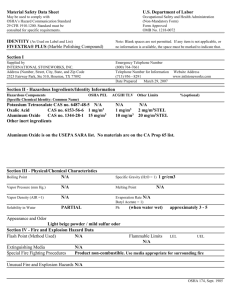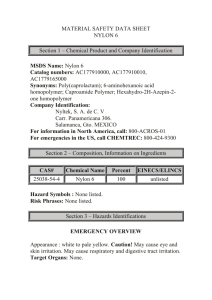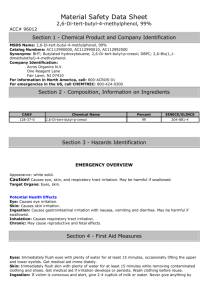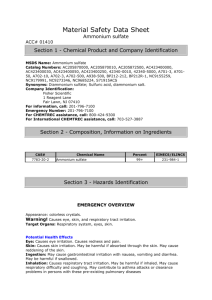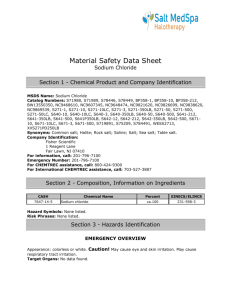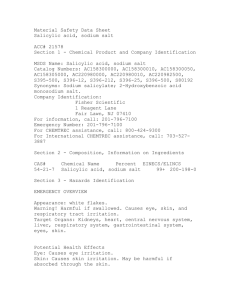Material Safety Data Sheet
advertisement
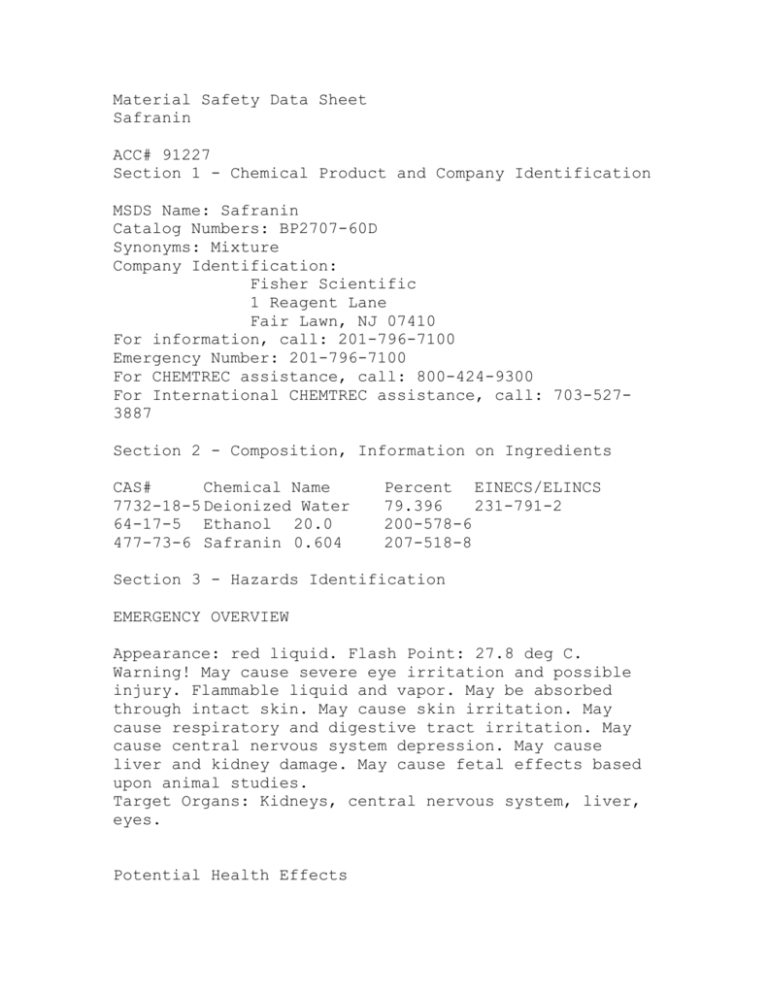
Material Safety Data Sheet Safranin ACC# 91227 Section 1 - Chemical Product and Company Identification MSDS Name: Safranin Catalog Numbers: BP2707-60D Synonyms: Mixture Company Identification: Fisher Scientific 1 Reagent Lane Fair Lawn, NJ 07410 For information, call: 201-796-7100 Emergency Number: 201-796-7100 For CHEMTREC assistance, call: 800-424-9300 For International CHEMTREC assistance, call: 703-5273887 Section 2 - Composition, Information on Ingredients CAS# Chemical Name 7732-18-5 Deionized Water 64-17-5 Ethanol 20.0 477-73-6 Safranin 0.604 Percent EINECS/ELINCS 79.396 231-791-2 200-578-6 207-518-8 Section 3 - Hazards Identification EMERGENCY OVERVIEW Appearance: red liquid. Flash Point: 27.8 deg C. Warning! May cause severe eye irritation and possible injury. Flammable liquid and vapor. May be absorbed through intact skin. May cause skin irritation. May cause respiratory and digestive tract irritation. May cause central nervous system depression. May cause liver and kidney damage. May cause fetal effects based upon animal studies. Target Organs: Kidneys, central nervous system, liver, eyes. Potential Health Effects Eye: Produces irritation, characterized by a burning sensation, redness, tearing, inflammation, and possible corneal injury. Vapors may cause eye irritation. May cause painful sensitization to light. Skin: May cause skin irritation. May be absorbed through the skin in harmful amounts. Ingestion: May cause kidney damage. May cause systemic toxicity with acidosis. May cause liver and kidney damage. May cause central nervous system depression, characterized by excitement, followed by headache, dizziness, drowsiness, and nausea. Advanced stages may cause collapse, unconsciousness, coma and possible death due to respiratory failure. Inhalation: Harmful if inhaled. May cause respiratory tract irritation. May cause liver and kidney damage. May cause narcotic effects in high concentration. May cause drowsiness, unconsciousness, and central nervous system depression. Chronic: Prolonged or repeated skin contact may cause dermatitis. Chronic inhalation may cause effects similar to those of acute inhalation. Section 4 - First Aid Measures Eyes: Immediately flush eyes with plenty of water for at least 15 minutes, occasionally lifting the upper and lower eyelids. Get medical aid imme diately. Skin: Get medical aid. Rinse area with large amounts of water for at least 15 minutes. Ingestion: Call a poison control center. If swallowed, do not induce vomiting unless directed to do so by medical personnel. Never give anything by mouth to an unconscious person. Get medical aid. Inhalation: Get medical aid immediately. Remove from exposure and move to fresh air immediately. If not breathing, give artificial respiration. If breathing is difficult, give oxygen. Notes to Physician: Treat symptomatically and supportively. Section 5 - Fire Fighting Measures General Information: If breathing is difficult, give oxygen. As in any fire, wear a self-contained breathing apparatus in pressure-demand, MSHA/NIOSH (approved or equivalent), and full protective gear. During a fire, irritating and highly toxic gases may be generated by thermal decomposition or combustion. Use water spray to keep fire-exposed containers cool. Combustible liquid. Containers may explode when heated. Extinguishing Media: Use water spray to cool fireexposed containers. Use water spray, dry chemical, carbon dioxide, or chemical foam. Do NOT use straight streams of water. Cool containers with flooding quantities of water until well after fire is out. Flash Point: 27.8 deg C ( 82.04 deg F) Autoignition Temperature: Not available. Explosion Limits, Lower:3.3 Upper: 19 NFPA Rating: (estimated) Health: 1; Flammability: 3; Instability: 0 Section 6 - Accidental Release Measures General Information: Use proper personal protective equipment as indicated in Section 8. Spills/Leaks: Sweep up, then place into a suitable container for disposal. Remove all sources of ignition. Absorb spill using an absorbent, non-combustible material such as earth, sand, or vermiculite. Do not use combustible materials such as sawdust. Provide ventilation. Section 7 - Handling and Storage Handling: Wash thoroughly after handling. Use with adequate ventilation. Avoid contact with eyes, skin, and clothing. Empty containers retain product residue, (liquid and/or vapor), and can be dangerous. Keep container tightly closed. Keep away from heat, sparks and flame. Avoid ingestion and inhalation. Do not pressurize, cut, weld, braze, solder, drill, grind, or expose empty containers to heat, sparks or open flames. Storage: Keep away from heat, sparks, and flame. Keep away from sources of ignition. Store in a tightly closed container. Store in a cool, dry, well-ventilated area away from incompatible substances. Section 8 - Exposure Controls, Personal Protection Engineering Controls: Use adequate general or local exhaust ventilation to keep airborne concentrations below the permissible exposure limits. Exposure Limits Chemical Name ACGIH NIOSH OSHA - Final PELs Deionized Water none listed none listed none listed Ethanol 1000 ppm TWA 1000 ppm TWA; 1900 mg/m3 TWA 3300 ppm IDLH 1000 ppm TWA; 1900 mg/m3 TWA Safranin none listed none listed none listed OSHA Vacated PELs: Deionized Water: No OSHA Vacated PELs are listed for this chemical. Ethanol: 1000 ppm TWA; 1900 mg/m3 TWA Safranin: No OSHA Vacated PELs are listed for this chemical. Personal Protective Equipment Eyes: Wear appropriate protective eyeglasses or chemical safety goggles as described by OSHA's eye and face protection regulations in 29 CFR 1910.133 or European Standard EN166. Skin: Wear appropriate protective gloves to prevent skin exposure. Clothing: Wear appropriate protective clothing to prevent skin exposure. Respirators: Follow the OSHA respirator regulations found in 29 CFR 1910.134 or European Standard EN 149. Use a NIOSH/MSHA or European Standard EN 149 approved respirator if exposure limits are exceeded or if irritation or other symptoms are experienced. Section 9 - Physical and Chemical Properties Physical State: Liquid Appearance: red Odor: pungent odor pH: Not available. Vapor Pressure: 40 mm Hg @19 deg C Vapor Density: 1.59 Evaporation Rate:Not available. Viscosity: Not available. Boiling Point: 95 deg C Freezing/Melting Point:Not available. Decomposition Temperature:Not available. Solubility: Soluble in water. Specific Gravity/Density:1 Molecular Formula:Not available. Molecular Weight:Not available. Section 10 - Stability and Reactivity Chemical Stability: Stable under normal temperatures and pressures. Conditions to Avoid: Incompatible materials, ignition sources, excess heat. Incompatibilities with Other Materials: Ethanol is incompatible with acetic anhydride, acetyl bromide, ammonia + silver nitrate, disulfuric acid + nitric acid, dichloromethane + sulfuric acid, disulfuryl difluoride, magnesium perchlorate, nitric acid + silver, oxidants, phosphorus (III) oxide, platinum, potassium, potassium tert-butoxide, silver nitrate, silver oxide, sodium and tetrachlorosilane. Hazardous Decomposition Products: Hydrogen chloride, carbon monoxide, oxides of nitrogen, carbon dioxide, formaldehyde. Hazardous Polymerization: Will not occur. Section 11 - Toxicological Information RTECS#: CAS# 7732-18-5: ZC0110000 CAS# 64-17-5: KQ6300000 CAS# 477-73-6: SG1623000 LD50/LC50: CAS# 7732-18-5: Oral, rat: LD50 = >90 mL/kg; . CAS# 64-17-5: Draize test, rabbit, eye: 500 mg Severe; Draize test, rabbit, eye: 500 mg/24H Mild; Draize test, rabbit, skin: 20 mg/24H Moderate; Inhalation, mouse: LC50 = 39 gm/m3/4H; Inhalation, rat: LC50 = 20000 ppm/10H; Oral, mouse: LD50 = 3450 mg/kg; Oral, rabbit: LD50 = 6300 mg/kg; Oral, rat: LD50 = 7060 mg/kg; Oral, rat: LD50 = 9000 mg/kg; . CAS# 477-73-6: . Carcinogenicity: CAS# 7732-18-5: Not listed by ACGIH, IARC, NTP, or CA Prop 65. CAS# 64-17-5: Not listed by ACGIH, IARC, NTP, or CA Prop 65. CAS# 477-73-6: Not listed by ACGIH, IARC, NTP, or CA Prop 65. Epidemiology: This product contains ethanol which have been shown to produce fetoxicity in the embryo or fetus. Teratogenicity: No information found Reproductive Effects: Prenatal exposure to ethanol is associated with a distinct pattern of congenital malformations that have been collectively termed the "fetal alcohol syndrome". Among the characteristics of this syndrome are intrauterine and postnatal growth deficiency, a distinctive pattern of physical malformation, and behavioral/cognitive impairment such as fine motor dysfunction and mental retardation. Not all affected children have all of the features of the syndrome. Mutagenicity: No data available. Neurotoxicity: No information found Other Studies: Section 12 - Ecological Information No information available. Section 13 - Disposal Considerations Chemical waste generators must determine whether a discarded chemical is classified as a hazardous waste. US EPA guidelines for the classification determination are listed in 40 CFR Parts 261.3. Additionally, waste generators must consult state and local hazardous waste regulations to ensure complete and accurate classification. RCRA P-Series: None listed. RCRA U-Series: None listed. Section 14 - Transport Information US DOT Canada TDG Shipping Name: Not regulated as a hazardous material No information available. Hazard Class: UN Number: Packing Group: Section 15 - Regulatory Information US FEDERAL TSCA CAS# 7732-18-5 is listed on the TSCA inventory. CAS# 64-17-5 is listed on the TSCA inventory. CAS# 477-73-6 is listed on the TSCA inventory. Health & Safety Reporting List None of the chemicals are on the Health & Safety Reporting List. Chemical Test Rules None of the chemicals in this product are under a Chemical Test Rule. Section 12b None of the chemicals are listed under TSCA Section 12b. TSCA Significant New Use Rule None of the chemicals in this material have a SNUR under TSCA. CERCLA Hazardous Substances and corresponding RQs None of the chemicals in this material have an RQ. SARA Section 302 Extremely Hazardous Substances None of the chemicals in this product have a TPQ. SARA Codes CAS # 64-17-5: immediate, delayed, fire. CAS # 477-73-6: immediate, reactive. Section 313 No chemicals are reportable under Section 313. Clean Air Act: This material does not contain any hazardous air pollutants. This material does not contain any Class 1 Ozone depletors. This material does not contain any Class 2 Ozone depletors. Clean Water Act: None of the chemicals in this product are listed as Hazardous Substances under the CWA. None of the chemicals in this product are listed as Priority Pollutants under the CWA. None of the chemicals in this product are listed as Toxic Pollutants under the CWA. OSHA: None of the chemicals in this product are considered highly hazardous by OSHA. STATE CAS# 7732-18-5 is not present on state lists from CA, PA, MN, MA, FL, or NJ. CAS# 64-17-5 can be found on the following state right to know lists: California, New Jersey, Pennsylvania, Minnesota, Massachusetts. CAS# 477-73-6 is not present on state lists from CA, PA, MN, MA, FL, or NJ. California Prop 65 WARNING: This product contains Ethanol, a chemical known to the state of California to cause developmental reproductive toxicity. California No Significant Risk Level: None of the chemicals in this product are listed. European/International Regulations European Labeling in Accordance with EC Directives Hazard Symbols: Not available. Risk Phrases: Safety Phrases: WGK (Water Danger/Protection) CAS# 7732-18-5: No information available. CAS# 64-17-5: 0 CAS# 477-73-6: No information available. Canada - DSL/NDSL CAS# 7732-18-5 is listed on Canada's DSL List. CAS# 64-17-5 is listed on Canada's DSL List. CAS# 477-73-6 is listed on Canada's DSL List. Canada - WHMIS This product has a WHMIS classification of B3. This product has been classified in accordance with the hazard criteria of the Controlled Products Regulations and the MSDS contains all of the information required by those regulations. Canadian Ingredient Disclosure List CAS# 64-17-5 is listed on the Canadian Ingredient Disclosure List. Section 16 - Additional Information MSDS Creation Date: 4/16/1999 Revision #7 Date: 10/31/2007 The information above is believed to be accurate and represents the best information currently available to us. However, we make no warranty of merchantability or any other warranty, express or implied, with respect to such information, and we assume no liability resulting from its use. Users should make their own investigations to determine the suitability of the information for their particular purposes. In no event shall Fisher be liable for any claims, losses, or damages of any third party or for lost profits or any special, indirect, incidental, consequential or exemplary damages, howsoever arising, even if Fisher has been advised of the possibility of such damages.



